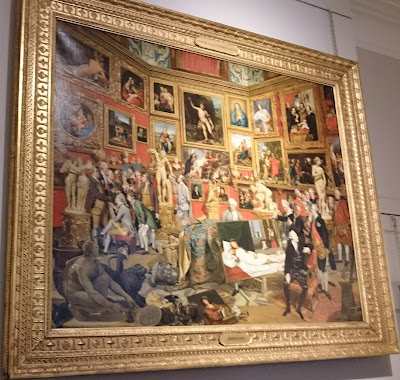Enlightened Princesses: Caroline, Augusta, Charlotte and the Shaping of the Modern World was an exhibition at Kensington Palace, London, which ran from 22 June until 12 November 2017.
Who were these enlightened princesses?
The enlightened princesses were three German princesses who married into the Georgian royal family:
Caroline of Ansbach (1683-1737) – wife of George II
 | |
| Queen Caroline by J Highmore (c1735) Royal Collection Photo from The First Georgians exhibition |
Augusta of Saxe-Gotha (1719-1772) – wife of Frederick, Prince of Wales, and mother of George III
 |
| Princess Augusta of Wales by Jean-Etienne Liotard (1754) Royal Collection |
Charlotte of Mecklenburg-Strelitz (1744-1818) – wife of George III
 |
| Queen Charlotte by Johan Joseph Zoffany (1771) Royal Collection |
Why were they considered ‘enlightened’?
These three German princesses had widespread interests in art, medicine, science and charitable concerns which they pursued with enthusiasm. Together they changed the role of women in the royal family and influenced the development of British culture.
What objects are on display?
The exhibition includes objects owned by the princesses and reflects their diverse interests.The following pictures are just a taster of the items on display.
Queen Charlotte and inoculation
Queen Charlotte was an advocate of inoculation against smallpox and supported Edward Jenner’s research which determined that cowpox vaccination was less hazardous than smallpox vaccination.
 |
| Left arm showing cowpox inoculation compared to smallpox inoculation Watercolour by G Kirtland after Charles Gold (1802) Wellcome Library, London |
Kew Gardens
All three princesses were interested in botany and gardening. Queen Caroline developed the gardens at Richmond Lodge and commissioned buildings and sculpture, whilst her daughter-in-law Princess Augusta developed the botanical gardens at Kew and commissioned the Orangery and the Pagoda.
 |
| Elevation of the Great Pagoda, Kew, as first intended T Miller after William Chambers (1763) Board of Trustees of the Royal Botanic Gardens, Kew |
Queen Charlotte continued to develop the gardens at Kew and expanded the collection of exotic plants. She also kept a menagerie which inclued a pair of Nilgai - Asian antelope.
 |
| The Nilgai by George Stubbs (1769) Hunterian Museum and Art Gallery, University of Glasgow |
Foundling Hospital
The princesses actively supported charities, particularly those that helped women and children, including the Magdalen Hospital, of which Queen Charlotte was patroness, and the Foundling Hospital.
 |
| Foundling tokens from the Foundling Hospital |
British industry
Queen Charlotte supported national industry including the silk-weavers at Spitalfields. The photograph shows fragments of material from dresses worn by the royal family for the wedding of the future George IV and Caroline of Brunswick in 1795, some of which were woven in Spitalfields.
 |
| Queen's silk samples Historic Royal Palaces |
Progressive education
Queen Caroline’s children were taught how to turn a lathe. The photograph shows the work of her eldest daughter, Princess Anne.
 |
| Woodturnings by Princess Anne (1709-1759) Royal Collections, the Netherlands |
Princess Augusta’s children used a camera obscura both as a drawing aid and as a means of entertainment. The placard under the camera obscura explains that it ‘projected a reversed image of an object through its lens onto a glass screen’.
 |
| Camera obscura - Stephen Demainbray, before 1753 King's College London |
Lady Charlotte Finch, governess to Queen Charlotte’s children, used dissected geographical maps, flash cards and counters to educate her royal pupils.
 |
| Group of dissected maps of America - Lady Charlotte Finch Historic Royal Palaces and V&A Museum of Childhood |
Needlework
This needlework pocket-book is thought to have been made by Queen Charlotte as a gift for her friend, the artist Mrs Delany. It contains tools for making the paper mosaics for which Mrs Delany is famous.
 |
| Needlework pocket-book - Queen Charlotte (1781) Lent by Her Majesty the Queen |
Tribuna of the Uffizi
Many drawings and paintings are on display, including what for many is the highlight of the exhibition – this vibrant painting by Johan Zoffany of the Tribuna room in the Uffizi Gallery in Florence which was commissioned by Queen Charlotte.
© Various collections as indicated. All photographs © RegencyHistory.net
Many drawings and paintings are on display, including what for many is the highlight of the exhibition – this vibrant painting by Johan Zoffany of the Tribuna room in the Uffizi Gallery in Florence which was commissioned by Queen Charlotte.
 |
| Tribuna of the Uffizi by J Zoffany (1772-8) Lent by Her Majesty the Queen |
Rachel Knowles writes faith-based Regency romance and historical non-fiction. She has been sharing her research on this blog since 2011. Rachel lives in the beautiful Georgian seaside town of Weymouth, Dorset, on the south coast of England, with her husband, Andrew.
Find out more about Rachel's books and sign up for her newsletter here.If you have enjoyed this blog and want to encourage me and help me to keep making my research freely available, please buy me a virtual cup of coffee by clicking the button below.



No comments:
New comments are not allowed.